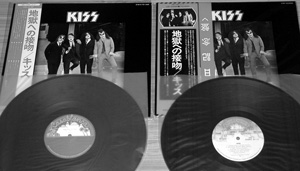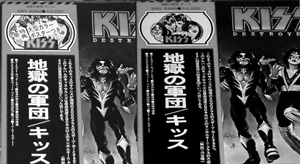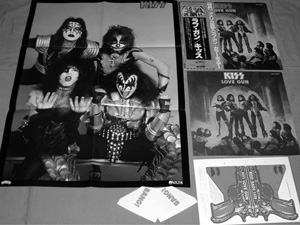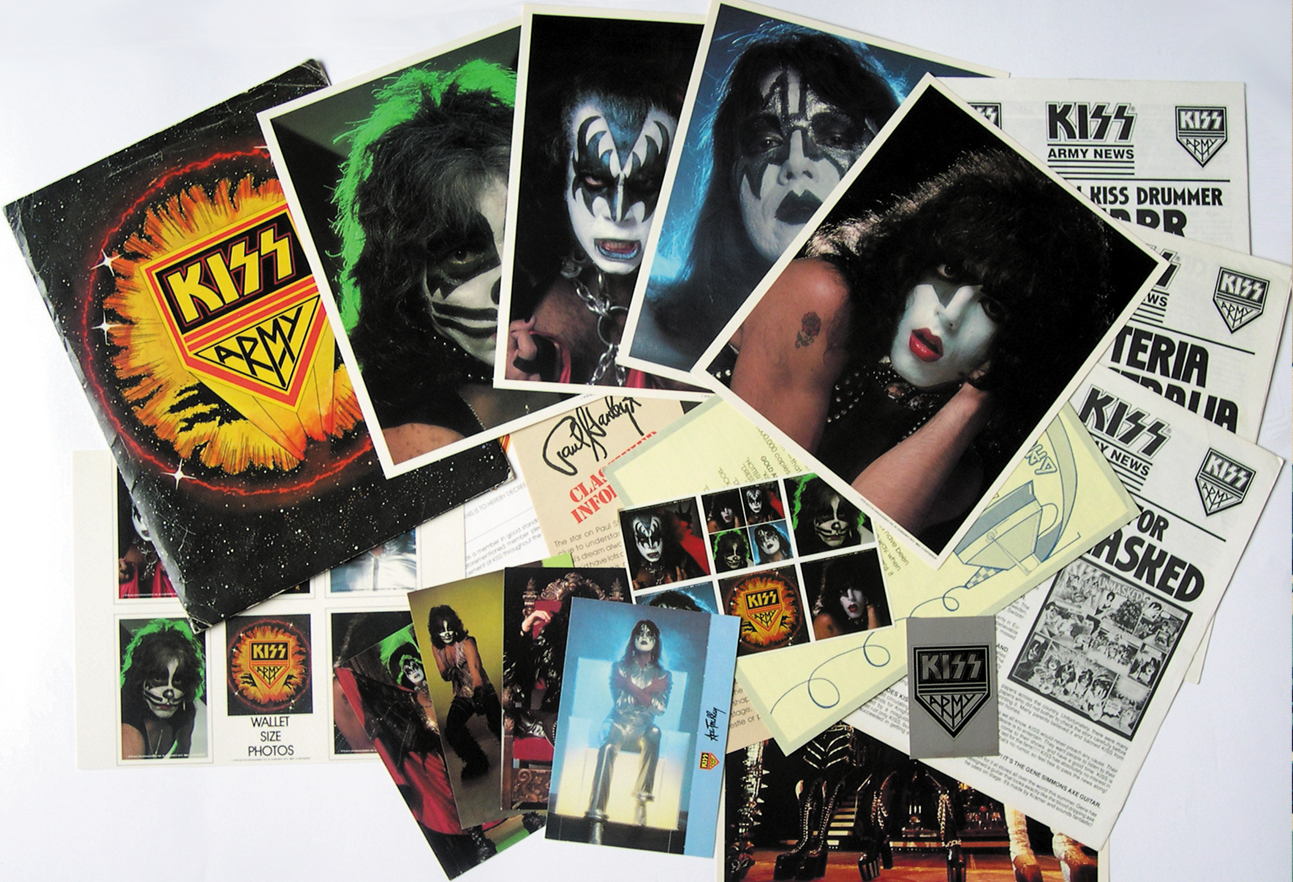I.2.1: JAPAN
Releases from Japan are one of the most interesting KISS items to collect. But the vast amount of variations can be utterly confusing if you don’t have the right information. More than that, the hunt for a complete Japanese KISS catalogue is getting harder every day and you have to face that your collection will always have some gaps. By researching info for this chapter, it was amazing to see how many permutations and varieties exist of Japanese releases and their inserts as well as the extra goodies that were issued at their original date of release.
Victor Years
At the time the first two albums were released in the U.S. in 1974, KISS was literary unknown overseas. In the summer of 1975, Casablanca sealed a deal with Victor Musical Industries, Inc. and Dressed To Kill was the first KISS album domestically released on July 25th, 1975, accompanied by the first Japanese single, Rock And Roll All Nite.
 Until early 1976, every Victor release carried a specific serial number prefix: LP’s got “SWX”, double albums “SJET” and EP’s (known as singles in most other countries) “JET”. Albums featured either white/red or white/pink/red obi, some with text only and some with both text and photos. When the Japanese distribution deal came to fruition, media coverage was very low and the first releases sold poorly. Even the shipping of Destroyer on April 10th, 1976 was followed by only minor press clippings. But only less than one year later, KISS craze would hit the country by storm and would not fade out until the fall of 1978. Between April 1976 and November 1977, Victor released ten KISS albums, making it one release every two months. With the Japan Tours in spring of both 1977 and 1978, six more albums were issued between November 1977 and October 1978, resulting in a total of 16 albums and 14 EP’s in just two and a half years.
Until early 1976, every Victor release carried a specific serial number prefix: LP’s got “SWX”, double albums “SJET” and EP’s (known as singles in most other countries) “JET”. Albums featured either white/red or white/pink/red obi, some with text only and some with both text and photos. When the Japanese distribution deal came to fruition, media coverage was very low and the first releases sold poorly. Even the shipping of Destroyer on April 10th, 1976 was followed by only minor press clippings. But only less than one year later, KISS craze would hit the country by storm and would not fade out until the fall of 1978. Between April 1976 and November 1977, Victor released ten KISS albums, making it one release every two months. With the Japan Tours in spring of both 1977 and 1978, six more albums were issued between November 1977 and October 1978, resulting in a total of 16 albums and 14 EP’s in just two and a half years.
With the release of Destroyer in April 1976, the obi got a new layout. The white/red colour scheme was replaced by a bolder red/white/black design with a cartoon image of KISS on top. This would remain the basic design until 1980 although some albums featured photos instead of the cartoon on top of the obi. More than that, Victor started to package KISS albums in a special way to compete against cheaper exports from the U.S. and to give the record buyers something special. Destroyer got a gatefold jacket while a very limited number of copies came with a colour poster, promoted in a little white box printed across the cartoon visages. Most of the Destroyer “SWX” pressings didn’t include the poster and thus came without the white box.
 With the release of the album’s first single Shout It Out Loud, the serial number prefix changed to “VIP” and would remain the standard for all releases until 1980. Shortly after Destroyer hit the market, the albums KISS and Hotter Than Hell were released for the first time.
With the release of the album’s first single Shout It Out Loud, the serial number prefix changed to “VIP” and would remain the standard for all releases until 1980. Shortly after Destroyer hit the market, the albums KISS and Hotter Than Hell were released for the first time.
As first indications for KISS’ rising popularity became apparent, Dressed To Kill, Alive! and Destroyer were re-issued, as well. All of these albums featured the new red/white/black obi design and the now-standard VIP serial number prefix. Starting with the release of Rock And Roll Over on December 5th, 1976, KISS albums were issued in Japan corresponding to their date of release in the U.S. In March 1977, Eddie Kramer arrived in Japan to record four shows at the Budokan Hall for an upcoming live album entitled Rock ’N’ Roll Party In Tokyo. As the release was cancelled for whatever reason, an edited 60-minute special from the concerts appeared on the American cable channel Home Box Office in July 1977 while bootlegs of the audio tapes became available in fan circles during the nineties.
 On July 10th, Love Gun was released, being the third consecutive album packaged in a gatefold sleeve with bonus poster. When buying a copy of ALIVE II, some stores handed out a rolled poster featuring a shot from the “On Cubes” series.
On July 10th, Love Gun was released, being the third consecutive album packaged in a gatefold sleeve with bonus poster. When buying a copy of ALIVE II, some stores handed out a rolled poster featuring a shot from the “On Cubes” series.
As the band returned to Japan on March 28th, 1978 to play four consecutive nights at Budokan, the probably best-known Japanese release The Originals II (a repackaging of Destroyer, Rock And Roll Over and Love Gun) was issued a few days earlier to commemorate the tour. Around this time, Victor released a limited cassette-only retrospective of KISS’ studio catalog, called The KISS Story. Each of these three volumes combined two earlier KISS albums. By purchasing the entire series, special KISS opera glasses with cartoon faces on top were issued in stores. The series still remains as one of the rarest Japanese items ever.
Silver cover jackets and cardboard awards from the Double Platinum package were imports from the U.S. But again, Japanese fans got a bonus poster with the set featuring a 1978 live shot enhanced with stars, lighning bolts and the KISS logo. The summer of 1978 saw an interesting release with a sampler called “The Guitar Technique Of Ace Frehley” by Toho Records. It features Ace’s makeup trademark on the cover and contained 8 songs.
(…)
Check out the book for more details on worldwide releases from the U.S., Japan, Europe, Australia, South America and many more…
